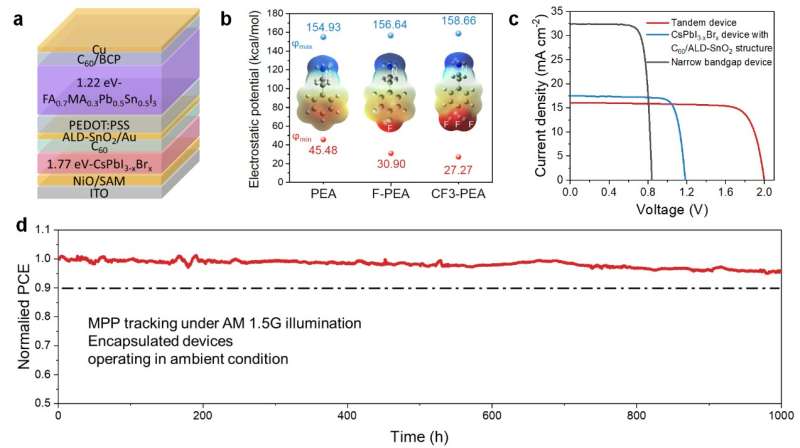May 2, 2023 feature
This article has been reviewed according to Science X's editorial process and policies. Editors have highlighted the following attributes while ensuring the content's credibility:
fact-checked
peer-reviewed publication
trusted source
proofread
New inorganic wide-bandgap perovskite subcells that are both efficient and stable

All-perovskite tandem solar cells, stacks of p-n junctions formed from perovskites with different energy bandgaps, have the potential of achieving higher efficiencies than conventional single-junction solar cells. So far, however, most proposed all-perovskite tandem cells have not achieved the desired power conversion efficiencies (PCEs), often due to difficulties associated with creating suitable narrow- and wide-bandgap subcells.
Researchers at Nanjing University and University of Toronto recently developed new inorganic wide-bandgap perovskite subcells that could increase the PCEs and stability of these promising solar cells. Their design, introduced in a paper in Nature Energy, involves the insertion of a passivating dipole layer at the interface between organic transport layers and inorganic perovskites within the cells.
"Our research group has been focusing on improving the PCEs of all-perovskite tandem solar cells, which have broken the world record several times and have been included in the 'solar cell efficiency tables,'" Hairen Tan, one of the researchers who carried out the study, told Tech Xplore.
"However, efficient tandem solar cells made using hybrid organic inorganic wide-bandgap perovskites have so far maintained only 90% of their initial PCE for 600 hours of operation at their maximum power point (MPP). Therefore, achieving long-term stability has emerged as a critical issue for the commercialization of all-perovskite tandem solar cells."
All-inorganic perovskites comprising of CsPbI3-xBrx have been found to exhibit superior thermal and photostability than hybrid materials combining organic and inorganic perovskites. As part of their recent study, Tan and his colleagues therefore tried to use these materials to create all-perovskite tandem solar cells with better long-term operational stabilities. Specifically, they used CsPbI3-xBrx perovskites to create inorganic wide-bandgap subcells that could be integrated in all-perovskite tandem cells.
"Inorganic wide-bandgap perovskites typically have conduction band minimums higher than the equivalent hybrid perovskites with the same bandgap," Tan said. "The large conduction band offset (ΔEc ~ 0.7 eV) at the interface of perovskite/electron-transport layer (C60) not only severely hinders charge extraction and leads to large open-circuit voltage (VOC)losses,but also triggers the hysteresis in the forward and reverse J-V curves. To address this issue, we introduced a dipole layer with high molecular polarity (CF3-PEA) at the perovskite/C60 interface to reconfigure interfacial states, thereby improving band alignment and increasing the binding strength between inorganic perovskite and C60 contacts."
The most unique feature of the subcell design introduced by Tan and his colleagues is the dipole layer that the team introduced between organic and inorganic materials. This layer ultimately helps to overcome common issues associated with interfacial transfer in all-perovskite tandem solar cells.
This transfer, which is crucial to the stable functioning of the cells, is often inhibited by PEA passivators, materials that are typically used to interface organic and inorganic perovskites in the cells. The high polarity dipole CF3-PEA layer introduced by the researchers, on the other hand, does not inhibit interfacial transfer, significantly improving the overall PCE of the cells.
"Ours was the first study that utilized inorganic wide-bandgap perovskite subcells in all-perovskite tandem solar cells, achieving both high efficiency and long-term stability," Tan said. "This makes the commercialization of all-perovskite tandem solar cells more promising, which is critical for the sustainable development of the photovoltaic industry."
Using their proposed design strategy, the researchers created wide-bandgap cells exhibiting a highly promising PCE of 18.5%. They then used this wide-bandgap subcell to develop all-perovskite tandem solar cells that achieved a PCE of 25.6%.
Remarkably, Tan and his colleagues found that after 1,000h of simulated operation in the sun these cells retained 96% of their initial performance. In the future, their design could thus inform the fabrication of more efficient and reliable all-perovskite tandem solar cells that retain their performance and stability for longer periods of time.
"The inorganic wide-bandgap perovskites enable a significant advance in the operating stability of all-perovskite tandems; yet work remains to be done to increase the PCEs of all-perovskite tandem devices," Tan added. "To achieve PCEs beyond 30%, it will be required to improve the VOC of the wide-bandgap front subcell from 1.23 V reported herein to greater than 1.4 V, which may be obtained by further suppressing bulk and surface recombination. Combining computational and experimental effort offers a promising direction for the rational design of efficient passivators in the future."
More information: Tiantian Li et al, Inorganic wide-bandgap perovskite subcells with dipole bridge for all-perovskite tandems, Nature Energy (2023). DOI: 10.1038/s41560-023-01250-7
Renxing Lin et al, All-perovskite tandem solar cells with improved grain surface passivation, Nature (2022). DOI: 10.1038/s41586-021-04372-8
© 2023 Science X Network















